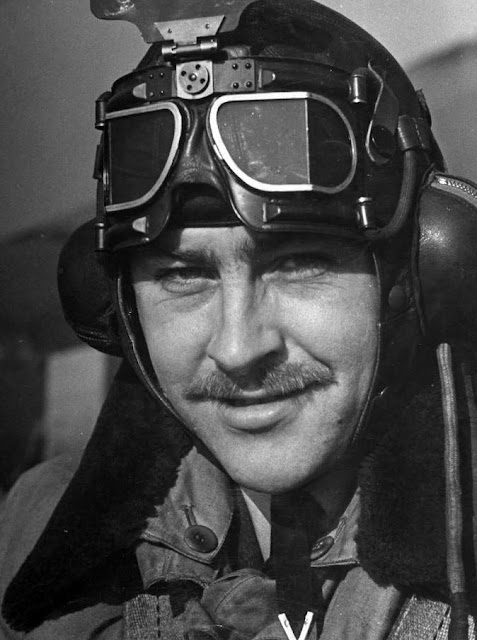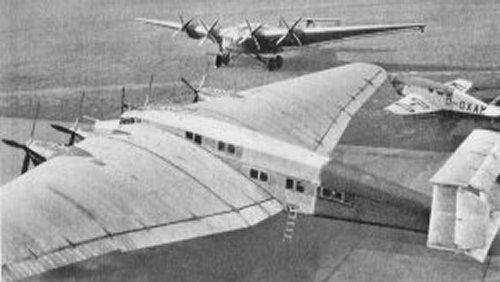Saturday 17 May 1941
On the ground, the scratch British garrison at Habbaniya Airfield continues its unexpectedly stout defense against the Iraqi military with great success. The British relief column, Kingcol, reaches Habbaniya late in the evening, but the Habbaniya garrison was in no need of rescue. The newly arrived British forces then continue their advance east to within ten miles of Fallujah on the road to Baghdad.
The Soviet TASS News Agency announces that the USSR and Rashid Ali government in Iraq have reached an agreement for diplomatic, trad and consular arrangements.
 |
| Illustrated London News, 17 May 1941. |
RAF Bomber Command completes its missions over Cologne and Bramsfeld begun on the 16th, and during the day sends 70 aircraft to attack Kiel. At Bramsfeld the Atlantik rubber plant is hit with two high explosive bombs and 44 incendiary bombs. After dark, Bomber Command sends 14 bombers against Rotterdam and 15 against Boulogne.
 |
| Lieutenant Stanley Michel Kolendorski, KIA 17 May 1941. |
The British Ministry of Home Security announces that 6,065 people were killed and 6,926 injured during Luftwaffe attacks in April 1941. Among the dead, 2912 were men and 2418 were women, and 680 were children under the age of 16. An additional 61 people remain missing and are presumed dead. The figures are an increase from the 4259 killed and 5,557 injured in April 1941.
East African Campaign: The Sudan Defense Force, accompanied by Abyssinian guerilla forces, attack Italian positions at Chilga west of Gondar.
At Amba Alagi, surrender negotiations are concluded between the Duke of Aosta and the British (Indian and South African troops). An agreement for the Italians to surrender is reached at 17:30. It is to be a "surrender with honor," and the Italians will be permitted to march out with their rifles (to be surrendered later) but leave behind their other equipment and stores. The ceremony of surrender is to take place on 19 May. The Italians are forced to surrender due to lack of supplies, a situation exacerbated when a British artillery shell damaged the oil tank they were using to store their potable water.
 |
| "Six Blenheim Mark IVFs of No. 254 Squadron RAF, flying in formation over Northern Ireland shortly after the unit's arrival at Aldergrove, County Antrim." May 1941. © IWM (CH 2992). |
The Luftwaffe (Focke-Wulf Fw 200 aircraft of I Staffeln, Kampfgeschwader 40) bombs and sinks 7939-ton British freighter Statesman in the Northwest Approaches. There is one death.
The Luftwaffe bombs and damages 1091 ton British freighter Arthur Wright and 933-ton Norwegian freighter Ala five miles south of Shoreham. Ala has to be beached near Shoreham but later is refloated and repaired. There is one death on Ala, the rest of the two crews survive.
Winston Churchill, in a memo to First Lord of the Admiralty A.V. Alexander and First Sea Lord and Chief of Naval Staff Admiral Dudley Pound, requests that ten of the Royal Navy's 40 large armed merchant cruisers (AMCs) be converted into troop transports.
Royal Navy ocean boarding vessel HMS Registan captures 488 ton Vichy French auxiliary schooner Izarra near Canada and sends it to St. John's, Newfoundland.
Four German freighters are reported to have left Chilean ports in an attempt to run the Royal Navy blockade of Europe.
Convoy OB 323 departs from Liverpool, Convoy SL 75 departs from Freetown bound for Liverpool.
Canadian corvette HMCS Dauphin (Lt. Commander Robert A. S. MacNeil) is commissioned and corvette Summerside is launched in Quebec City.
U-206 (Oberleutnant zur See Herbert Opitz) is commissioned, U-134 is launched, U-212, U-261, and U-465 are laid down.
 |
| The four-engine Junkers G-38. The last one is destroyed on 17 May 1941. |
The only tangible benefit of the offensive is that the British remain in possession of strategically important Halfaya Pass. However, that that small gain has cost the British five tanks destroyed and 13 damaged in addition to 206 casualties. The Germans have suffered 295 casualties and Italians 395 (347 captured), along with losing three tanks lost and about the same number damaged.
At Tobruk, fresh Australian troops and their artillery pieces arrive during the night on destroyer HMAS Vampire. By first light, the troops and guns are used to attack the investing Axis troops, but they make no progress.
Winston Churchill cables Middle East Commander General Archibald Wavell and begins with "Results of action [Operation Brevity] seem to us satisfactory." He notes that "News from Tobruk is also good." He makes an extremely rare direct reference to Ultra decrypts (which Wavell knows about) when he writes that "Enemy is anxious about Tobruk and reports with apparent satisfaction when it is quiet."
The RAF (Beaufighters of No. 252 Squadron based on Malta) raids Athens airfield and destroys the second - and last - Junkers G.38 (the "Generalfeldmarschall von Hindenburg") being operated by the Luftwaffe (after long service with Lufthansa) on the ground. The G.38 is an obsolete 1929 design but has an advanced design that foreshadows the "Blended Wing Body" design that offers aerodynamic advantages and will experience a resurgence of popularity by Boeing and NASA in the 21st Century. It also is one of the few four-engine designs ever used by the Wehrmacht and features unique seats in the wings for passengers with forward-facing windows.
The Luftwaffe continues its attack on British installations on Crete in preparation for Operation Mercury, the invasion of Crete. At Suda Bay, the German planes sink 10,694-ton British tanker Eleonora Maersk (20 killed, 7 later become POWs, 17 rescued) and 5719 ton Greek freighter Themoni. The Eleonora Maersk will stay sunk throughout the war but will be raised and repaired thereafter.
The Luftwaffe drops mines in the Suez Canal.
Tanker Rondine, carrying 5000 tons of aviation fuel, arrives later than expected at Athens. Operation Mercury accordingly is postponed to 20 May, which now appears to be a firm invasion date.
Quiet day on Crete, with the Luftwaffe only performing minimal reconnaissance.
War Crimes: The Luftwaffe attacks 7938-ton hospital ship Aba about fifty miles south of Crete. Some Royal Navy ships of Force C come to the hospital ship's aid, and one, anti-aircraft cruiser HMS Coventry, is strafed by the Luftwaffe planes. Attacking hospital ships, which are plainly marked, is a war crime, but it is fair to say that both sides have been guilty (under some interpretations) of violations of such commonly accepted rules of war.
 |
| Bomb damage in Birmingham, 17 May 1941 (Birmingham City Library). |
Applied Science: Vannevar Bush creates the Office of Scientific Research and Development (OSRD). Separately, Arthur Compton and the United States National Academy of Sciences together publish a report about favorable prospects for the invention of an atomic bomb.
German Military: Adolf Hitler issues his Directive No. 29, which addresses "The aim of German operations in the southeast," i.e., the Balkans and Crete. The main points of the Directive are that the Italians will be primarily responsible for defending Greece, and how Crete will be garrisoned - its capture being assumed in upcoming Operation Mercury.
 |
| A Curtiss-Wright Navy SNC-1 trainer airplane, 17 May 1941. |
The Dies Committee investigating un-American activities announces that it will hold hearings next week regarding "the extent to which Communist and Communist sympathizers have been able to obtain employment in the federal government."
Italian Government: King Victor Emmanuel III of Italy is in Albania visiting Albanian Prime Minister Shefqet Vërlaci when both are shot at in their car. The culprit is 19-year old Albanian nationalist Vasil Laçi, who will be executed on 27 May.
Philippines: A load of 31 P-40B fighters arrives by ship and is transported to Nichols Field, the only paved airfield capable of handling fighters. The shipment does not include the Prestone antifreeze which is necessary for their operation - so the planes are unusable until the coolant arrives. This will not be until early July, and training is critical because P-40s are considered tough to fly, especially by inexperienced pilots.
American Homefront: It is "Connie Mack Day" at Shibe Park in Philadelphia, PA.
 |
| Connie Mack Day program at Shibe Park, Philadelphia, 17 May 1941. In 1953, Shibe Park will be renamed Connie Mack Stadium and demolished on 13 July 1976 after being replaced by Veterans Stadium. |
May 1941
May 1, 1941: British Hold Tobruk
May 2, 1941: Anglo-Iraq War
May 3, 1941: Liverpool Hammered
May 4, 1941: Hitler Victory Speech
May 5, 1941: Patriots Day
May 6, 1941: Stalin In Command
May 7, 1941: May Blitz
May 8, 1941: Pinguin Sunk
May 9, 1941: U-110 Captured
May 10, 1941: Hess Flies Into History
May 11, 1941: The Hess Peace Plan
May 12, 1941: Tiger Arrives Safely
May 13, 1941: Keitel's Illegal Order
May 14, 1941: Holocaust in Paris
May 15, 1941: Operation Brevity
May 16, 1941: Blitz Ends
May 17, 1941: Habbaniya Relieved
May 18, 1941: Croatia Partitioned
May 19, 1941: Bismarck at Sea
May 20, 1941: Invasion of Crete
May 21, 1941: Robin Moore Sinking
May 22, 1941: Royal Navy Destruction Off Crete
May 23, 1941: Crete Must Be Won
May 24, 1941: Bismarck Sinks Hood
May 25, 1941: Lütjens' Brilliant Maneuver
May 26, 1941: Bismarck Stopped
May 27, 1941: Bismarck Sunk
May 28, 1941: Crete Lost
May 29, 1941: Royal Navy Mauled Off Crete
May 30, 1941: Sorge Warns, Stalin Ignores
May 31, 1941: British Take Baghdad
2020


No comments:
Post a Comment